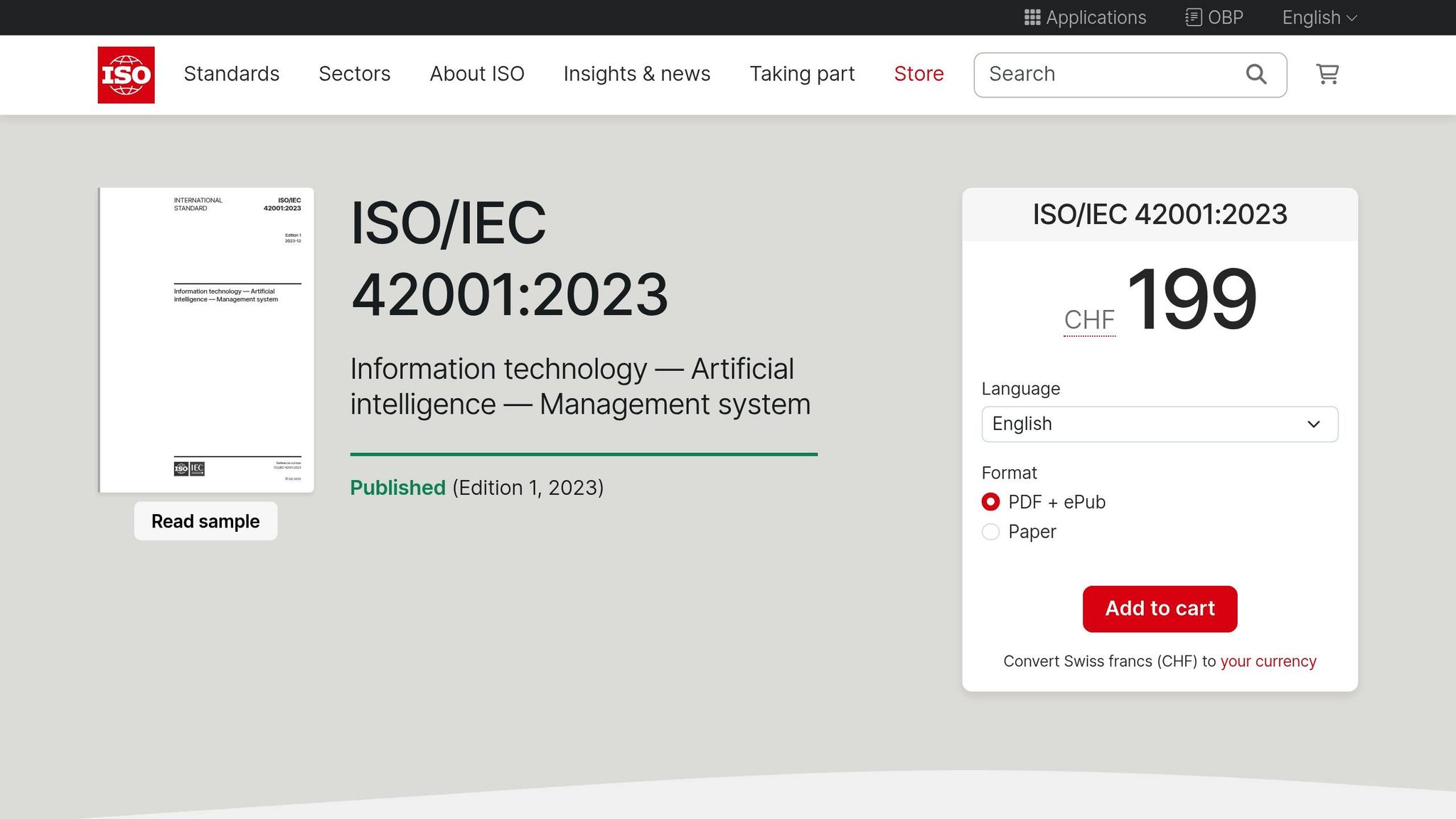ISO 42001 is a global standard for managing AI systems responsibly and effectively. It focuses on risk management, ethical practices, and operational efficiency, offering businesses a clear framework to ensure AI compliance while building stakeholder trust. Here's what you need to know:
-
Core Requirements:
- Document AI processes (development, testing, deployment).
- Conduct regular risk assessments (privacy, bias, security).
- Ensure ethical AI use (transparency, fairness, accountability).
-
Key Benefits:
- Reduces AI-related risks with structured management.
- Improves operational consistency and system reliability.
- Builds trust with stakeholders through transparency.
- Aligns with evolving AI regulations.
-
Compliance Steps:
- Assess current practices and identify gaps.
- Develop and integrate an AI management system.
- Undergo certification audits (6-8 months process).
- Maintain certification with annual reviews and updates.
For SMEs, ISO 42001 offers practical tools to adopt AI responsibly without compromising efficiency. While challenges like documentation and cost exist, automation and careful planning can streamline compliance efforts.
ISO 42001 Requirements

AI Management System Elements
ISO 42001 outlines key elements for managing AI systems effectively:
- Document the development, testing, and deployment of AI systems.
- Monitor performance regularly, using clear metrics to assess system effectiveness.
- Manage changes by establishing procedures to track and implement updates.
- Allocate resources by ensuring both technical and human resources are in place.
Organizations should integrate these elements with existing workflows and assign clear roles for overseeing AI systems.
| Component | Required Documentation | Review Frequency |
|---|---|---|
| AI System Architecture | Technical specifications, data flows | Quarterly |
| Training Data | Source documentation, validation records | Monthly |
| Model Performance | Accuracy metrics, error rates | Weekly |
| Incident Reports | Issue logs, resolution steps | As needed |
These elements are critical for meeting ISO 42001 standards.
Risk Management Process
ISO 42001 emphasizes a structured approach to identifying and mitigating risks associated with AI systems.
Identify Risks
- Data privacy violations
- Algorithmic bias
- Potential system failures
- Security weaknesses
Assess Impact
- Evaluate the likelihood and severity of risks.
- Consider how risks affect stakeholders.
- Estimate potential financial costs.
- Review regulatory implications.
Implement Controls
- Use technical safeguards and monitoring systems.
- Develop operational procedures.
- Establish response protocols for incidents.
Organizations must document their risk assessment methods and keep risk registers updated. Regular reviews help ensure that controls remain effective, enabling proactive management of AI-related risks.
AI Ethics Requirements
ISO 42001 places strong focus on ethical AI practices. The framework includes the following principles:
1. Transparency
Organizations must document key aspects of AI decision-making, such as:
- How decisions are made
- Policies for data usage
- Assessments of potential impacts
2. Fairness and Non-discrimination
AI systems should be designed to avoid bias. This involves:
- Conducting regular bias testing
- Using diverse datasets for training
- Maintaining records of fairness metrics
3. Accountability
Clear accountability structures are essential. This includes:
- Appointing ethics officers
- Conducting regular ethical audits
- Establishing channels for stakeholder feedback
| Ethical Principle | Implementation Requirement | Verification Method |
|---|---|---|
| Transparency | Document AI logic and processes | External audit |
| Fairness | Establish bias testing protocols | Statistical analysis |
| Accountability | Define roles and responsibilities | Compliance review |
| Privacy | Implement data protection measures | Security assessment |
To meet these ethical standards, organizations must regularly assess and update their AI practices, ensuring they align with ISO 42001 guidelines.
ISO 42001: AI compliance & what you need to know
ISO 42001 Compliance Benefits
ISO 42001 provides clear advantages for improving operations and strengthening credibility in the market.
Improved AI Control and Safety
ISO 42001 enhances how organizations manage and secure AI systems. Implementing these standards leads to more effective operational processes:
Key Controls
- Continuous monitoring identifies problems early.
- Standardized protocols ensure quick issue resolution.
- Regular testing maintains system reliability.
- Clear procedures safeguard sensitive information.
| Control Aspect | Before ISO 42001 | After ISO 42001 |
|---|---|---|
| Risk Detection | Ad-hoc monitoring | Continuous assessment |
| Issue Response | Variable procedures | Standardized protocols |
| System Testing | Inconsistent methods | Regular validation |
| Data Protection | Basic safeguards | Advanced security |
These measures support risk management efforts and align with ethical guidelines.
Strengthened Market Position and Trust
Achieving ISO 42001 certification can elevate an organization’s reputation and build trust.
Competitive Edge
- Showcases commitment to responsible AI governance.
- Simplifies AI development and deployment processes.
- Strengthens relationships with vendors and partners.
Operational Gains
- Fewer AI-related issues thanks to systematic controls.
- Faster deployment with established frameworks.
- Improved risk management across AI projects.
This certification signals to stakeholders that the organization prioritizes responsible AI practices and maintains high operational standards.
sbb-itb-bec6a7e
Getting ISO 42001 Certified
Initial Assessment
Start by evaluating your AI systems to pinpoint areas that don't meet ISO 42001 standards.
Key Focus Areas
- Governance structure and policies for AI systems
- Frameworks for managing risks
- Data handling and privacy practices
- Documentation and record-keeping processes
- Training programs and staff expertise
This evaluation usually takes about 4-6 weeks. The findings will guide the development of your AI management system.
Building an AI System
Once gaps are identified, create an AI management system that aligns with ISO 42001 requirements. This involves systematically adding necessary controls and processes.
Core Elements to Include
- Written AI policies and procedures
- Methods for assessing risks
- Tools to monitor performance
- Protocols for handling incidents
- A framework for ethical decision-making
| Phase | Duration | Key Outcomes |
|---|---|---|
| Planning | 4-8 weeks | Define scope, timeline, and resources |
| Development | 12-16 weeks | Establish policies, procedures, and controls |
| Testing | 6-8 weeks | Validate the system and train staff |
| Review | 4 weeks | Conduct internal audits and management reviews |
Certification Process
After building and testing the system, move to the formal certification stage. This process typically takes 6-8 months and involves several audits.
Steps to Certification
- Pre-assessment Review: Conduct an internal audit of documents and systems.
- Stage 1 Audit: Certification body performs an initial evaluation.
- Stage 2 Audit: A thorough compliance assessment is carried out.
- Certification Decision: Final review leads to certification issuance.
Maintaining Certification
Keep your certification active through annual audits, recertification every three years, ongoing monitoring, and regular staff training.
Common Obstacles
Meeting ISO 42001 requirements can be tough, with several practical challenges standing in the way.
Progress vs. Compliance
Balancing fast-paced AI development with ISO 42001 standards isn't easy. Companies often find it hard to innovate while meeting strict controls and documentation requirements.
Here are some of the biggest challenges:
- Documentation processes that slow down development
- Risk assessments that delay product releases
- Deployment bottlenecks caused by compliance checks
- Regular audits that require significant resources
To tackle these issues, automating compliance monitoring can help. By tracking changes in AI systems in real time, you can cut down on manual oversight while staying compliant.
Some practical steps include:
- Embedding compliance checks directly into development workflows
- Using standardized templates for risk assessments
- Factoring compliance tasks into sprint planning
While these measures are essential for maintaining system integrity, they often come with additional costs and staffing challenges.
Budget and Staff Needs
Achieving ISO 42001 certification can be expensive, especially for small and medium-sized businesses. However, careful planning and automation can help manage these costs.
Here are some cost-saving ideas:
- Use AI-powered tools to simplify documentation, risk assessments, and performance tracking
- Train your current technical team on compliance procedures to avoid hiring additional staff
- Automate repetitive tasks with AI tools to reduce workload
- Bring in external consultants for specific, high-need phases
Overcoming these challenges is key to both obtaining and maintaining ISO 42001 certification.
Conclusion
ISO 42001 provides a structured approach to deploying AI responsibly and ethically, ensuring that innovation aligns with safety and accountability.
Key Takeaways
Core Requirements
- Develop a comprehensive AI management system
- Conduct thorough risk assessments
- Maintain detailed documentation of AI processes
- Uphold ethical practices in AI deployment
Steps for Implementation
- Start with an initial assessment of current practices
- Embed compliance into daily workflows
- Automate documentation processes
- Train staff effectively to support compliance
Ongoing Advantages
- Enhanced reliability of AI systems
- Increased trust among stakeholders
- Lower operational risks
- Competitive edge in the market
ISO 42001 serves as a critical framework for managing AI across its lifecycle. While challenges may arise, organizations can overcome them by adopting systematic controls and leveraging automation. Regular reviews are essential to stay aligned with the standard and ensure continuous improvement.


